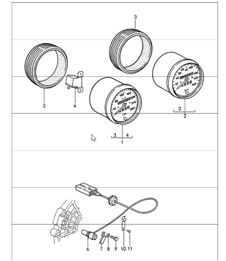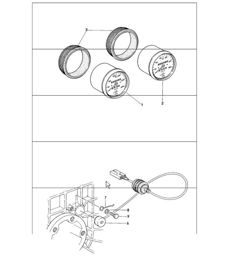Speed / Reference / Knock Sensors
also known are Engine Crankshaft Position Sensor
The engine crankshaft position sensor (CPS) is a critical component that monitors the crankshaft’s position and rotational speed. It sends this data to the engine control unit (ECU), allowing precise control of fuel injection, ignition timing, and other key engine functions. Without accurate input from the CPS, the ECU cannot properly synchronize spark or fuel delivery—leading to poor performance or even a no-start condition.
Crankshaft sensors typically use magnetic or Hall-effect technology:
Magnetic sensors generate a signal with a coil and magnet as the crankshaft rotates.
Hall-effect sensors detect changes in the magnetic field using a semiconductor for highly accurate readings.
Depending on the engine design, the CPS is usually located near the crankshaft pulley, harmonic balancer, flywheel, or transmission. It reads notches or teeth on a tone wheel to create a signal the ECU can interpret.
Over time, heat, vibration, and contaminants (oil, dirt, or metal shavings) can cause the sensor to fail. When this happens, common symptoms include engine stalling, rough idling, misfires, or a no-start condition.
Fits:- Porsche 911 1984-1986 3.2L
- Porsche 911 1987-1989 3.2L G50
- Porsche 911 1978-1989 3.3L Turbo (930)
Common Symptoms of a Failing Crankshaft Position Sensor
· No Start Condition – If the ECU doesn’t receive a proper signal, the engine won’t start.
· Stalling When Warm – The sensor may fail when the engine reaches operating temperature, causing unexpected stalling.
· Erratic or Dead Tachometer – In some vehicles, a faulty CPS can cause the tachometer to behave irregularly.
· Check Engine Code P0335 – A failed internal circuit may trigger this code, though not always.
· Poor Performance at Certain RPMs – Timing issues can cause hesitation, especially at idle or higher RPMs.
· Multiple Cylinder Misfires – Unlike a single bad coil or injector, CPS failure can cause misfires across all cylinders.
This crankshaft sensor is designed for Porsche 911 G models produced between 1984 and 1989. It serves as a pulse generator, transmitting engine speed data to the DME, and is a frequent culprit when the engine experiences irregular performance.
Identified by the Bosch number ending in 005, this sensor was installed in pairs within the vehicle. A reliable and precise pulse generator is crucial for optimal engine electronics performance.
Related reference numbers
Related, superseded, cross reference or alternative numbers for comparison.
91160621502
The product you are viewing cross references to these numbers
- Porsche 911 1984-1986 3.2L
- Porsche 911 1987-1989 3.2L G50
- Porsche 911 1978-1989 3.3L Turbo (930)

Electrical plug housing - multiple applications (see below).
Porsche 986 Boxster 1997-04
- Camshaft position sensor
- Throttle valve
- Ignition coil
Porsche 996 Carrera & GT3 1998-05
- Ignition coil
Porsche 964/993 Carrera & Turbo 1994-98
- Crankshaft position sensor
Related reference numbers
Related, superseded, cross reference or alternative numbers for comparison.
99965291640
The product you are viewing cross references to these numbers
 Shop Securely
Shop Securely
 12 Month Warranty
12 Month Warranty
 Worldwide Delivery
Worldwide Delivery
Electrical plug housing - multiple applications (see below).
Porsche 986 Boxster 1997-04
- Camshaft position sensor
- Throttle valve
- Ignition coil
Porsche 996 Carrera & GT3 1998-05
- Ignition coil
Porsche 964/993 Carrera & Turbo 1994-98
- Crankshaft position sensor
Related reference numbers
Related, superseded, cross reference or alternative numbers for comparison.
99965291640
The product you are viewing cross references to these numbers
 Shop Securely
Shop Securely
 12 Month Warranty
12 Month Warranty
 Worldwide Delivery
Worldwide Delivery


Fits:
Porsche 911 1984-89
Related reference numbers
Related, superseded, cross reference or alternative numbers for comparison.
91160621502
The product you are viewing cross references to these numbers
- Porsche 911 1984-1986 3.2L
- Porsche 911 1987-1989 3.2L G50
- Porsche 911 1978-1989 3.3L Turbo (930)
 Shop Securely
Shop Securely
 12 Month Warranty
12 Month Warranty
 Worldwide Delivery
Worldwide Delivery
also known are Engine Crankshaft Position Sensor
The engine crankshaft position sensor (CPS) is a critical component that monitors the crankshaft’s position and rotational speed. It sends this data to the engine control unit (ECU), allowing precise control of fuel injection, ignition timing, and other key engine functions. Without accurate input from the CPS, the ECU cannot properly synchronize spark or fuel delivery—leading to poor performance or even a no-start condition.
Crankshaft sensors typically use magnetic or Hall-effect technology:
Magnetic sensors generate a signal with a coil and magnet as the crankshaft rotates.
Hall-effect sensors detect changes in the magnetic field using a semiconductor for highly accurate readings.
Depending on the engine design, the CPS is usually located near the crankshaft pulley, harmonic balancer, flywheel, or transmission. It reads notches or teeth on a tone wheel to create a signal the ECU can interpret.
Over time, heat, vibration, and contaminants (oil, dirt, or metal shavings) can cause the sensor to fail. When this happens, common symptoms include engine stalling, rough idling, misfires, or a no-start condition.
Fits:- Porsche 911 1984-1986 3.2L
- Porsche 911 1987-1989 3.2L G50
- Porsche 911 1978-1989 3.3L Turbo (930)
Common Symptoms of a Failing Crankshaft Position Sensor
· No Start Condition – If the ECU doesn’t receive a proper signal, the engine won’t start.
· Stalling When Warm – The sensor may fail when the engine reaches operating temperature, causing unexpected stalling.
· Erratic or Dead Tachometer – In some vehicles, a faulty CPS can cause the tachometer to behave irregularly.
· Check Engine Code P0335 – A failed internal circuit may trigger this code, though not always.
· Poor Performance at Certain RPMs – Timing issues can cause hesitation, especially at idle or higher RPMs.
· Multiple Cylinder Misfires – Unlike a single bad coil or injector, CPS failure can cause misfires across all cylinders.
Related reference numbers
Related, superseded, cross reference or alternative numbers for comparison.
91160621502
The product you are viewing cross references to these numbers
- Porsche 911 1984-1986 3.2L
- Porsche 911 1987-1989 3.2L G50
- Porsche 911 1978-1989 3.3L Turbo (930)
 Shop Securely
Shop Securely
 12 Month Warranty
12 Month Warranty
 Worldwide Delivery
Worldwide Delivery

Fits:
Porsche 928
Porsche 924S
Porsche 944
Porsche 968
Related reference numbers
Related, superseded, cross reference or alternative numbers for comparison.
94460611500
The product you are viewing cross references to these numbers
- Porsche 911 1984-1986 3.2L
- Porsche 911 1987-1989 3.2L G50
- Porsche 911 1978-1989 3.3L Turbo (930)
- Porsche 924S 2.5L 1986-87
- Porsche 924S 2.5L 1988
- Porsche 944 2.5L 8V 1982-87
- Porsche 944 2.7L 8V 1988-89
- Porsche 944S 2.5L 16V 1987-88
- Porsche 944S2 3.0L 16V 1989-91
- Porsche 944 Turbo 2.5L 8V 1985-88
- Porsche 944 Turbo 2.5L 8V 1989-91
- Porsche 944 Turbo S 2.5L 8V 1988
- Porsche 968 3.0L 1992-94
- Porsche 968 Sport 3.0L 1994-95
- Porsche 968 CS 3.0L 1993-95
- Porsche 968 Turbo S 3.0L 1993-94
- Porsche 928 4.5L 1978-82
- Porsche 928S 4.7L 1981-83
- Porsche 928S2 4.7L 1984-86
- Porsche 928S4 5.0L 1987-92
- Porsche 928GT 5.0L 1989-91
- Porsche 928GTS 5.4L 1992-95
 Shop Securely
Shop Securely
 12 Month Warranty
12 Month Warranty
 Worldwide Delivery
Worldwide Delivery


Fits:
Porsche 911 1985-86 3.2L
Porsche 911 Turbo 1985-88
915 Gearbox type
Related reference numbers
Related, superseded, cross reference or alternative numbers for comparison.
91160620901
The product you are viewing cross references to these numbers
- Porsche 911 1984-1986 3.2L
- Porsche 911 1978-1989 3.3L Turbo (930)
 Shop Securely
Shop Securely
 12 Month Warranty
12 Month Warranty
 Worldwide Delivery
Worldwide Delivery
Fits:
Porsche 911 1987-89 3.2ltr
Porsche 911 Turbo 1989
G50 Gearbox type
Related reference numbers
Related, superseded, cross reference or alternative numbers for comparison.
91160691001
The product you are viewing cross references to these numbers
- Porsche 911 1987-1989 3.2L G50
- Porsche 911 1978-1989 3.3L Turbo (930)
 Shop Securely
Shop Securely
 12 Month Warranty
12 Month Warranty
 Worldwide Delivery
Worldwide Delivery
Speed, Reference & Knock Sensors – Precision Monitoring for Porsche Engine Performance
Speed, reference, and knock sensors are crucial components in your Porsche’s engine management system. They work together to provide the engine control unit (ECU) with accurate data about crankshaft position, engine speed, and vibration — allowing the system to adjust timing, fueling, and ignition for maximum performance and protection.
At Design911, we supply a comprehensive selection of genuine and high-quality sensors for all Porsche Models, including 911, Boxster, Cayman, Cayenne, Macan, and Panamera. Each sensor is engineered for precise signal output, reliability, and durability, ensuring consistent performance and optimal engine operation.
What Do Speed, Reference & Knock Sensors Do?
These sensors play distinct yet complementary roles in your
Porsche’s electronic control system:
- Speed
Sensors: Measure rotational speed of the wheels or crankshaft to
optimise traction, stability, and engine timing.
- Reference
Sensors: Provide accurate engine position data to control ignition
timing and fuel injection.
- Knock Sensors: Detect engine detonation (pinging) and send signals to the ECU to adjust ignition timing, preventing engine damage.
Together, they ensure your Porsche runs smoothly, efficiently, and safely under all driving conditions.
Why Do These Sensors Fail?
Due to exposure to heat, vibration, and contamination, these
sensors can degrade over time. Common causes of failure include:
- Heat
damage from proximity to engine or exhaust components.
- Wiring
corrosion or connector oxidation reducing signal accuracy.
- Mechanical
wear on sensor tips or mounting points.
- Contamination
from oil, dirt, or debris interfering with readings.
- Electrical interference or internal circuitry failure.
Typical symptoms of sensor failure include poor acceleration, engine misfires, erratic idle, loss of power, increased fuel consumption, or a check engine light.
Why Replace Faulty Sensors?
A failing sensor can lead to poor performance, reduced fuel efficiency, and even engine damage if left unchecked. Replacing worn or damaged sensors ensures the ECU receives accurate data, maintaining safe and efficient operation.
Benefits of replacement include:
- Restored ignition timing and fuel efficiency.
- Improved throttle response and smooth acceleration.
- Protection against detonation and engine wear.
- Reliable performance with manufacturer-quality precision.
All sensors in our range are designed with high-quality materials, advanced shielding, and precision calibration to deliver consistent readings and long-term reliability in demanding conditions.

















